Zinnias garden ideas can turn even the simplest yard into a vibrant, eye-catching escape. These cheerful blooms come in nearly every color imaginable and thrive with minimal fuss, making them a favorite among gardeners of all skill levels. Whether you’re planting a narrow border or crafting a full garden bed, zinnias offer incredible versatility and charm. From structured color arrangements to whimsical cottage-style plantings, the right design can elevate your entire landscape. In this article, we’ll explore ten cozy and creative ways to incorporate zinnias into your garden beds—each one designed to inspire, delight, and make your yard the envy of the neighborhood.
Table of Contents
1. Rainbow Border Garden
If you’re looking for bold and beautiful zinnias garden ideas, the rainbow border design is a showstopper. This layout arranges zinnias by color to mimic the hues of a rainbow, creating a stunning gradient that bursts with personality and curb appeal.
📐 Plan for a Layered Look
Start by sketching your garden bed and organizing it into layers based on plant height. Tall zinnias like Benary’s Giant or California Giant varieties should go in the back. Medium-height cultivars like the Oklahoma Series can fill the middle. Front rows should feature compact types such as Thumbelina zinnias, which stay under 12 inches tall. This height structure gives a full, lush look while letting every bloom shine.
🌺 Choose Your Rainbow Shades
To create the rainbow effect, plant zinnias in color order: red, orange, yellow, green (with lime zinnias), and purple. While true blue zinnias don’t exist, you can add depth with companion plants like blue salvia or bachelor’s buttons. Here’s a popular color lineup:
- Red: ‘Benary’s Giant Scarlet’
- Orange: ‘Oklahoma Salmon’
- Yellow: ‘Zowie! Yellow Flame’ or ‘Canary Bird’
- Green: ‘Envy’
- Purple: ‘Purple Prince’
- Blue (companion): Salvia or ageratum
🌿 Mix in Companion Plants
To make your border even more dynamic, pair zinnias with plants that add contrast or texture. Blue salvia helps fill out cooler tones, while airy plants like Verbena bonariensis or cosmos add movement and softness. Foliage plants like dusty miller or ornamental grasses can break up the bright colors and offer a calming balance.
🧱 Add a Finishing Edge
Polish the look with a neat border. Stone, brick, or even flexible metal edging works well to frame your design and keep the garden tidy. A defined edge makes colors pop and helps separate the rainbow from lawn or paths.
2. Cottage-Style Garden Bed

Among the most charming zinnias garden ideas is the cottage-style garden bed. This design is all about layering textures, mixing colors, and creating a soft, romantic look that feels both spontaneous and inviting.
🌸 Blend with Classic Cottage Flowers
In a cottage garden, zinnias pair perfectly with old-fashioned blooms like coneflowers, cosmos, snapdragons, and black-eyed Susans. Choose zinnias in pastel shades—lavender, peach, soft pink, and cream—to match the dreamy aesthetic. Varieties like Queen Lime Blush or Zinderella Peach are excellent choices.
Plant in natural groupings rather than straight rows. This relaxed approach gives the garden a wild, lived-in look that feels cozy and full of character.
🐝 Create a Pollinator Paradise
One of the best parts of this style? It doubles as a haven for pollinators. Cottage beds packed with nectar-rich zinnias and native wildflowers attract bees, butterflies, and hummingbirds all season long. Add herbs like lavender or oregano along the edges for scent and pollinator support.
🌿 Let the Foliage Soften the Scene
To avoid visual clutter, balance bold zinnias with airy greenery like feverfew, dill, or soft lamb’s ear. These filler plants add texture and create breathing room between your flowering clusters.
🪴 Pro Tip: Curved Bed Edges
Instead of rigid lines, curve your bed edges for a more organic feel. Use natural stone, worn wood, or even no edging at all to enhance the cottage vibe. Just be sure to mulch well to prevent weeds and retain moisture.
3. Raised Bed Zinnia Garden

For gardeners looking for tidy, manageable zinnias garden ideas, raised beds offer structure and convenience without sacrificing beauty. Whether you’re working with limited space or poor soil, a raised bed helps zinnias thrive while keeping your yard neat and organized.
🧱 Build the Right Base
Start with a raised bed that’s at least 10–12 inches deep and around 3–4 feet wide, allowing easy access from either side. Use rot-resistant wood, metal, or stone—just avoid treated lumber, which can leach harmful chemicals into your soil.
Fill your bed with a well-draining mix: a blend of compost, garden soil, and perlite or vermiculite. Zinnias love slightly loamy soil and will reward you with more blooms if they aren’t sitting in soggy conditions.
🌼 Design in Blocks, Not Rows
Instead of traditional straight-line planting, try block planting for a fuller look. Group zinnias by variety or color, creating mini patches that fill the bed with texture and contrast. For example, alternate rows of Benary’s Giant Orange and Purple Prince for dramatic visual impact.
Add edging plants like alyssum or sweet potato vine to spill gently over the sides and soften the look.
🛠️ Easy Maintenance Bonus
Raised beds make weeding, watering, and harvesting a breeze. They’re also perfect for installing drip irrigation or soaker hoses to keep moisture levels consistent. Since the soil warms up faster in spring, you can get a jumpstart on the growing season, especially in cooler climates.
4. Zinnia and Herb Garden Combo
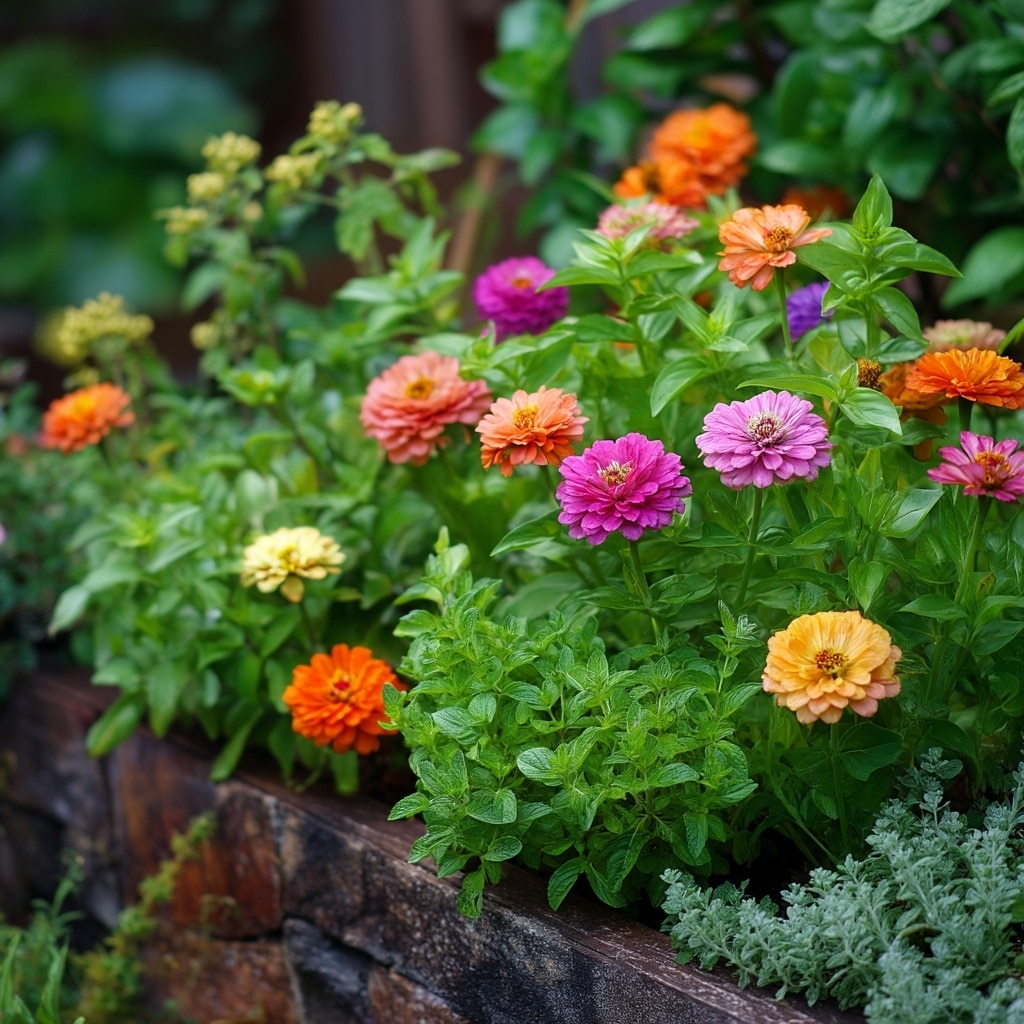
Looking for zinnias garden ideas that are as useful as they are beautiful? Pairing zinnias with herbs creates a colorful, fragrant garden bed that supports pollinators while giving you fresh harvests for the kitchen.
🍃 Mix Form and Function
Zinnias bring vibrant blooms, while herbs like basil, oregano, thyme, and dill offer rich textures and soothing greens. Choose compact zinnia varieties such as Profusion or Thumbelina that won’t overwhelm lower-growing herbs. This combination ensures both elements get the sunlight and space they need.
Plant zinnias in small drifts among herb groupings to create a mosaic of color and texture. A well-designed mix not only looks good but also helps deter pests and improve air circulation between plants.
🐝 Attract Beneficial Insects
Zinnias are a magnet for bees, butterflies, and hoverflies—some of nature’s best pollinators. Many herbs, especially those left to flower like dill or thyme, also attract beneficial bugs. This blend turns your garden into an insect-friendly powerhouse that supports natural pest control.
🌞 Ideal Layout Tips
For best results, position the tallest zinnias in the back or center (depending on the bed’s shape), and cascade outward with herbs. Keep plants spaced generously to encourage airflow, and mulch with straw or bark chips to retain moisture and prevent weeds.
Raised beds or large container groupings work especially well for this combo, making maintenance simple and harvests convenient.
5. Wildflower-Inspired Zinnia Bed
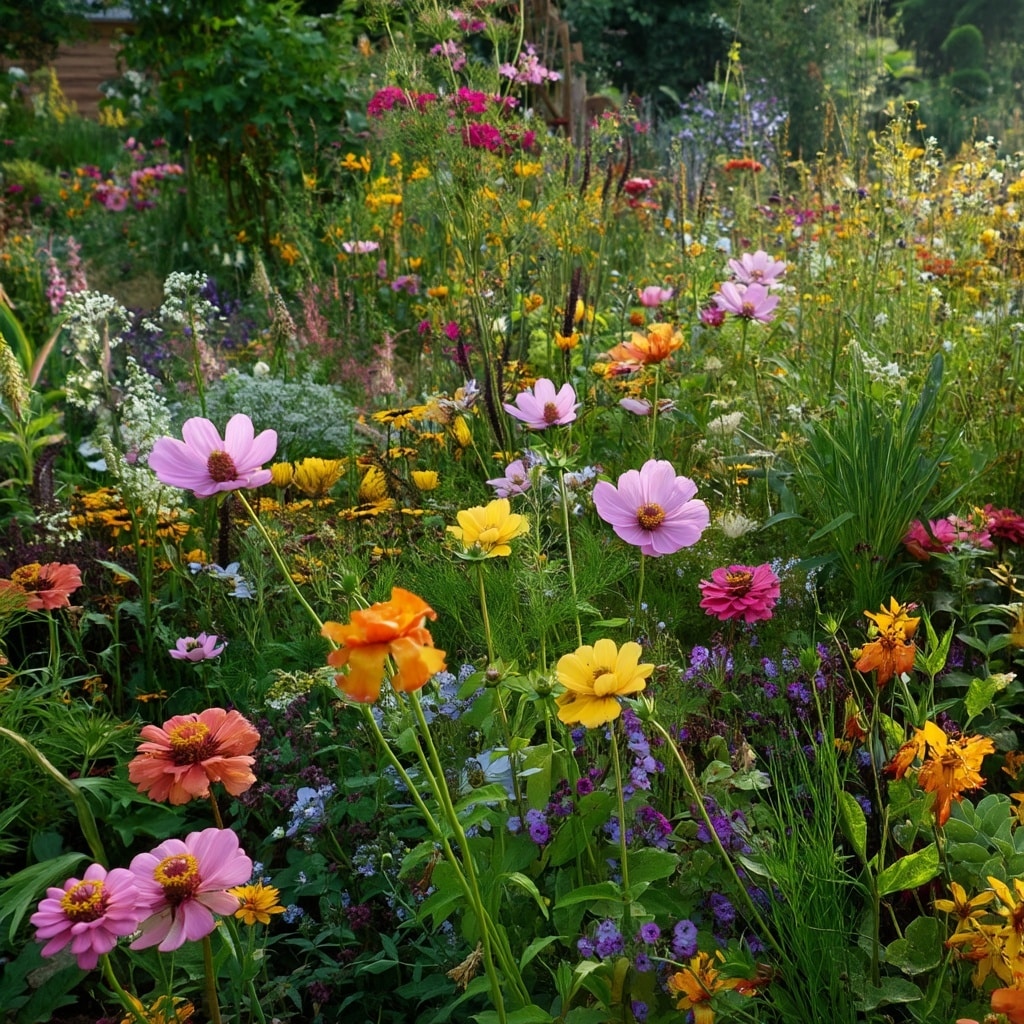
One of the most relaxed and joyful zinnias garden ideas is to plant them like wildflowers. This style mimics nature’s effortless beauty—perfect for creating a pollinator-friendly space that blooms from summer to fall with minimal effort.
🌼 Scatter and Sow
Instead of neat rows or formal groupings, broadcast zinnia seeds across a prepared patch of soil, mixing them with other annual wildflowers like coreopsis, cosmos, and rudbeckia. Use a rake to lightly cover the seeds, water well, and let nature take over.
Choose single-flower zinnia varieties such as Cut and Come Again or Lilliput, which mix easily with other blooms and allow bees and butterflies easier access to nectar.
🐞 Perfect for Pollinators and Wildlife
This naturalistic planting style attracts a wide variety of beneficial insects. From fluttering monarchs to buzzing native bees, wildflower-inspired beds offer food, shelter, and beauty. Add a shallow birdbath or pollinator puddling station to complete the habitat.
🌾 Embrace the Wild Aesthetic
Allow the plants to grow and lean into each other without pruning for a meadow-style effect. Use curved borders or irregular shapes for a more organic look. You can even mow winding paths through larger wildflower patches to encourage exploration and frame the blooms.
Because this design is looser and more spontaneous, it’s forgiving for beginners and ideal for filling large or awkward spaces in your yard.
6. Zinnia Color Block Garden
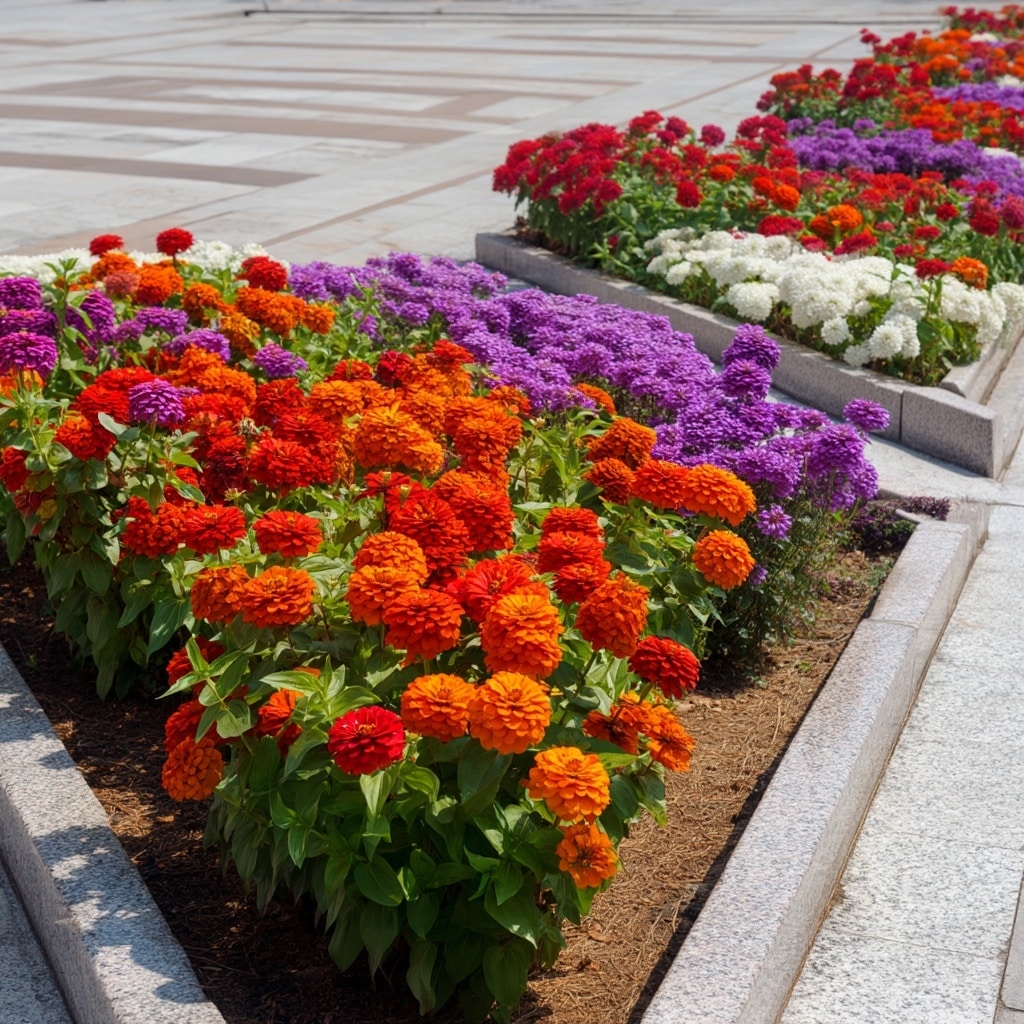
For gardeners who love strong visual impact, color blocking offers one of the most striking zinnias garden ideas. This design focuses on planting large patches of a single color for bold contrast and modern appeal.
🟥 Group by Color, Not Variety
Instead of mixing shades, pick a few distinct colors and dedicate a full section of your bed to each. For example, plant deep magenta Purple Prince zinnias in one block, bright orange Profusion Orange in another, and creamy white Polar Bear zinnias nearby. The sharp color divisions are bold, eye-catching, and incredibly photogenic.
You can achieve this look in rectangular beds, raised beds, or even large containers. For maximum drama, arrange the blocks in geometric shapes or alternating stripes.
🔁 Use Repetition for Harmony
Repeat your color blocks throughout the garden to create visual flow. This repetition pulls the eye across the landscape and ties everything together, even in larger spaces.
Leave space between each color section using neutral borders—like ornamental grasses, silver-foliaged plants (think dusty miller), or even mulch pathways—to help the colors stand out.
🌿 Companion Tips
Since color block gardens are all about contrast, avoid overly busy companion planting. Instead, choose subtle accent plants that won’t compete for attention. Think low-growing sweet alyssum, lobelia, or simple ferns to create calm transitions between colors.
This design also lends itself well to cut flower gardens, as the grouped colors are easy to harvest for monochrome or coordinated bouquets.
7. Zinnias in Vertical Garden Beds
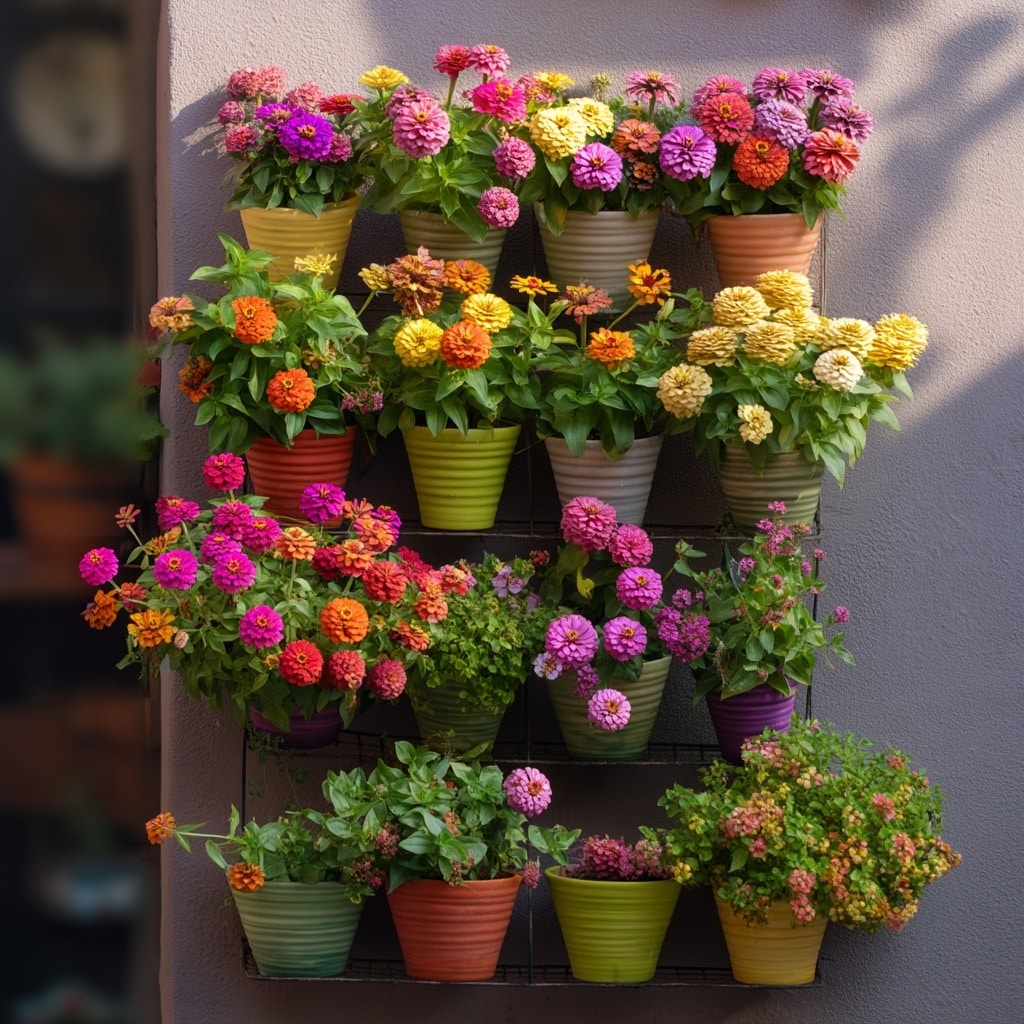
When space is at a premium, vertical planting becomes one of the smartest zinnias garden ideas. It lets you enjoy vibrant blooms even in small yards, patios, or balconies—without sacrificing impact.
🪜 Use Tiered Planters and Wall Structures
Start with stackable planters, wall-mounted pocket planters, or tiered shelving units. These setups allow you to layer multiple zinnia varieties at different heights. Compact zinnias like Profusion, Thumbelina, or Zahara are ideal, as they thrive in containers and stay bushy without sprawling.
For wall setups, make sure your structure gets full sun (at least 6–8 hours daily) and has proper drainage.
🌺 Maximize Color in a Small Footprint
Plant zinnias in contrasting colors for maximum visual interest—try orange and purple for a punchy combo, or pink and lime green for a playful palette. Because the eye is naturally drawn upward, vertical displays feel bigger and more dramatic than their footprint suggests.
Mix in cascading plants like sweet potato vine or trailing lobelia to soften the edges and add movement.
💧 Keep an Eye on Watering
Vertical beds dry out faster than in-ground ones, especially in hot weather. Use moisture-retaining potting mix, and consider installing drip irrigation or self-watering systems to keep your blooms happy. Group pots with similar watering needs together to simplify care.
Zinnias grown vertically are not only beautiful but also easier to harvest for bouquets or deadhead for continued blooming.
8. Zinnia Pathway Borders

If you love functional beauty, one of the most classic zinnias garden ideas is lining your pathways with vibrant zinnias. These flower-filled borders add instant charm and guide the eye naturally through your landscape.
🪴 Choose the Right Varieties for Edging
For borders along walkways, stick with compact or mid-height zinnias that won’t flop into the path. Ideal varieties include:
- Thumbelina – small, bushy, and perfect for tight edges
- Profusion – low-maintenance and continuous bloomers
- Oklahoma – slightly taller but still neat and tidy
Stagger plantings slightly for a more organic edge, or keep things crisp with straight lines if you prefer a formal look.
🎨 Play with Color Themes
You can go monochrome for a sophisticated feel—think all white or soft pastels—or alternate bold shades for a festive, welcoming vibe. Try coordinating your zinnia colors with nearby structures, like a painted fence or garden bench, to create visual harmony.
To highlight the border, add natural mulch or gravel paths that contrast nicely with the vivid blooms.
🌞 Keep It Low and Lush
Since zinnias love full sun, pathway beds are often ideal—they tend to be open and exposed. Just be sure not to overcrowd your plants, as proper airflow helps prevent powdery mildew. Plant zinnias about 6–12 inches apart depending on the variety.
These borders not only look great, but they’re also practical—providing easy access for deadheading, cutting flowers, or simply enjoying them up close as you walk by.
9. Pollinator-Friendly Zinnia Bed
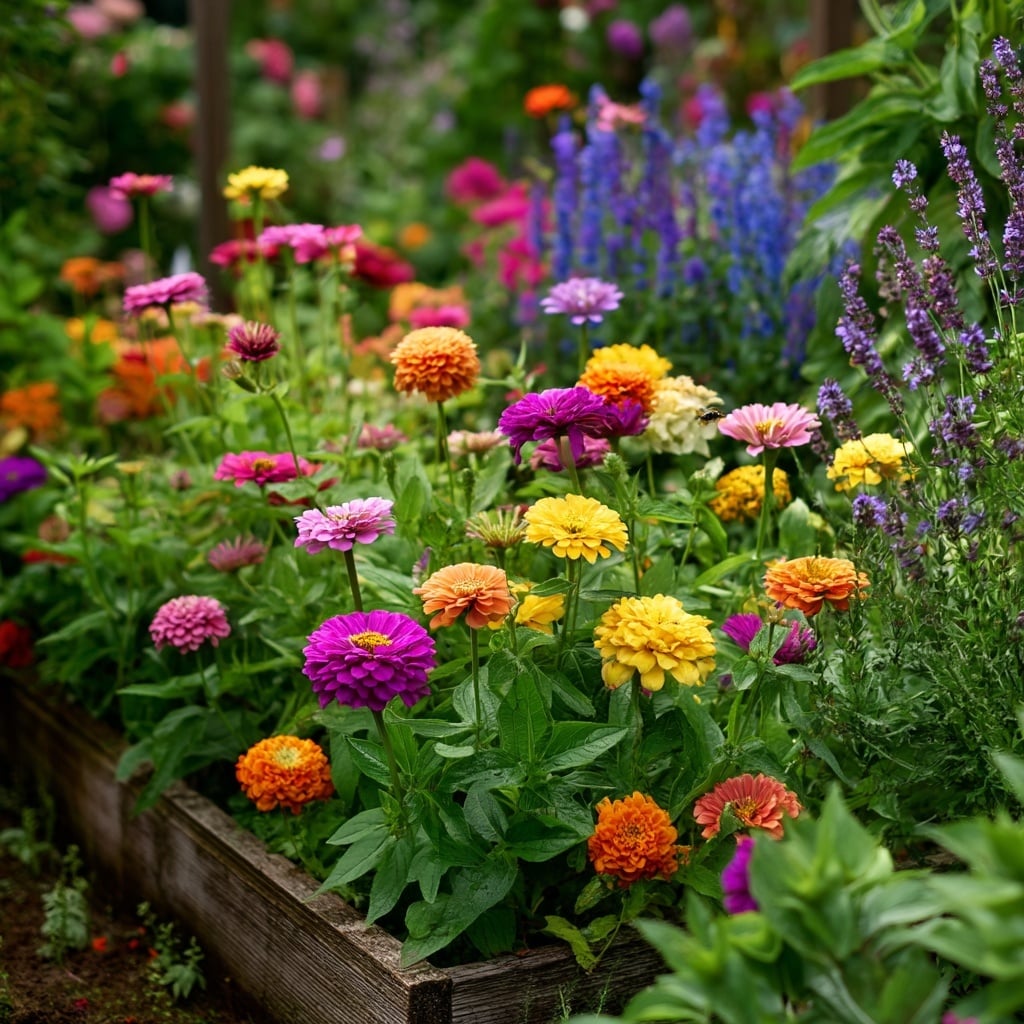
Among the most meaningful zinnias garden ideas is creating a dedicated pollinator bed. Zinnias are beloved by bees, butterflies, and hummingbirds—and when paired with other nectar-rich plants, they turn your garden into a buzzing, fluttering sanctuary.
🌼 Choose the Right Zinnia Varieties
Single-flowered zinnias are the top choice for pollinators because their centers are more exposed and easier to access. Opt for varieties like:
- Cut and Come Again
- Benary’s Giant (single-petal selections)
- Lilliput series
Plant in large clusters, as pollinators prefer mass plantings where they can gather nectar efficiently.
🌸 Pair with Pollinator Favorites
To boost the bed’s appeal, mix in other flowering plants that attract beneficial insects. Some excellent companions include:
- Lavender
- Milkweed (for monarchs)
- Coneflower
- Bee balm
- Cosmos
Vary bloom shapes and heights to accommodate different species and extend the feeding season.
💦 Keep It Organic and Inviting
Avoid chemical pesticides and herbicides in this type of bed, as they can harm beneficial insects. Instead, practice companion planting and natural pest control methods. Include flat stones or shallow water dishes with pebbles so bees can safely rest and hydrate.
Add signage or markers to help teach visitors about your pollinator patch. It’s a great way to share the beauty and purpose of your zinnia garden with neighbors or guests.
10. Zinnia Cutting Garden Bed

If you love fresh bouquets on your kitchen table, one of the most practical zinnias garden ideas is dedicating a bed entirely to cutting flowers. Zinnias are long-lasting in vases, easy to grow, and bloom prolifically with regular harvesting.
🌺 Prioritize High-Yield Varieties
Choose zinnias known for strong stems, large blooms, and long vase life. Some of the best cutting types include:
- Benary’s Giant – large, full blooms in vibrant colors
- Oklahoma Series – more compact but equally productive
- Queen Lime Series – unique tones perfect for arrangements
Stagger plantings every few weeks in early summer to ensure a continuous bloom cycle.
📏 Plant for Productivity
Design your cutting bed with straight rows and adequate space between plants (about 9–12 inches) to make harvesting easy. A rectangular layout works best, especially if you’re planting multiple varieties.
Use a trellis or low support netting if you’re growing taller varieties—this keeps stems straight and reduces breakage.
✂️ Harvesting Tips for More Blooms
Zinnias produce more flowers the more you cut. Snip stems in the early morning when they’re fully hydrated, just as blooms begin to open. Always use clean, sharp shears to avoid spreading disease.
Pair your zinnias with other great cut flowers like snapdragons, cosmos, amaranth, or celosia for endless bouquet possibilities.
This garden style doesn’t just provide beauty—it gives you the gift of fresh flowers all season long.
Conclusion
There’s no shortage of beautiful and practical zinnias garden ideas to transform your yard into a colorful retreat. Whether you prefer the structured elegance of color blocking, the whimsical charm of a cottage bed, or the productivity of a cutting garden, zinnias offer versatility, ease, and long-lasting blooms.
By choosing the right varieties, thoughtful layouts, and complementary plants, you can create a garden space that reflects your style and supports pollinators, too. Start small or go bold—but either way, zinnias are sure to deliver big results.
Happy planting!




